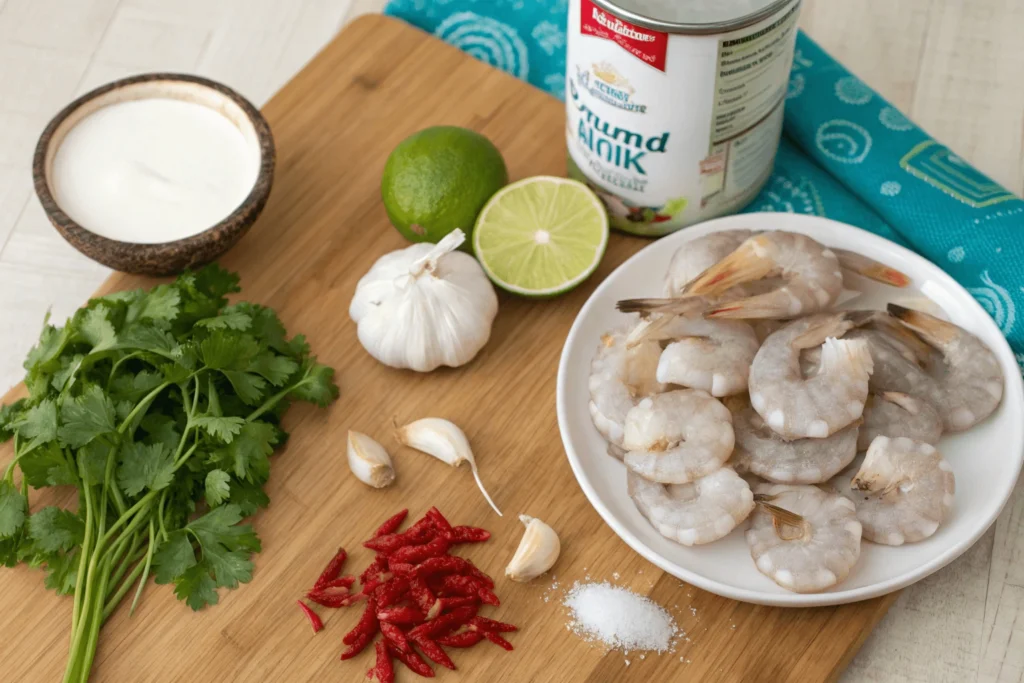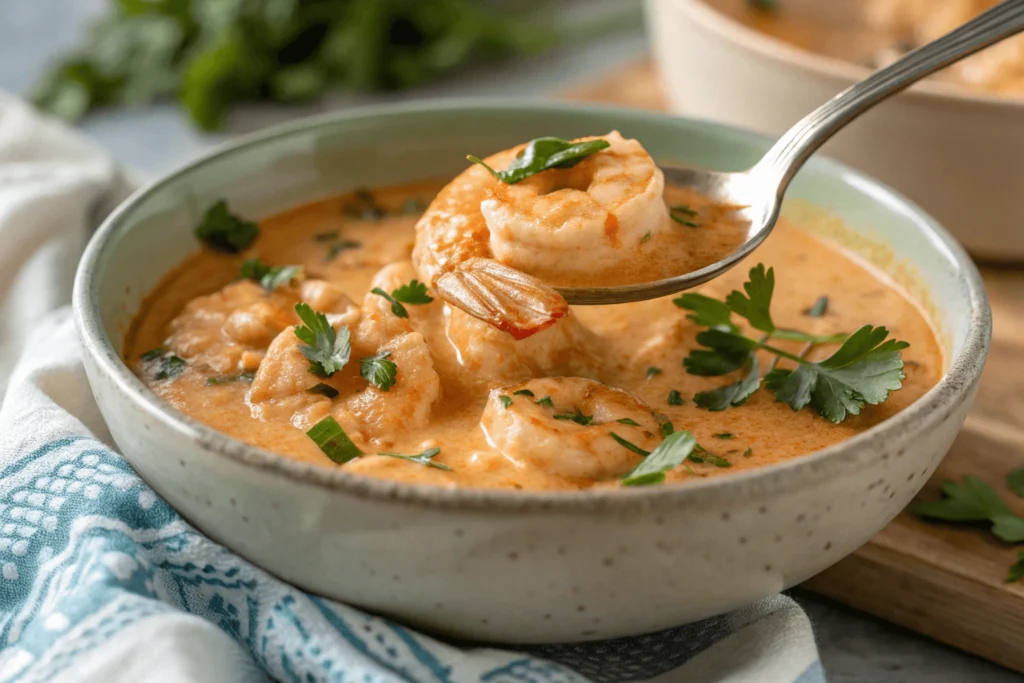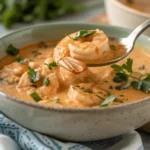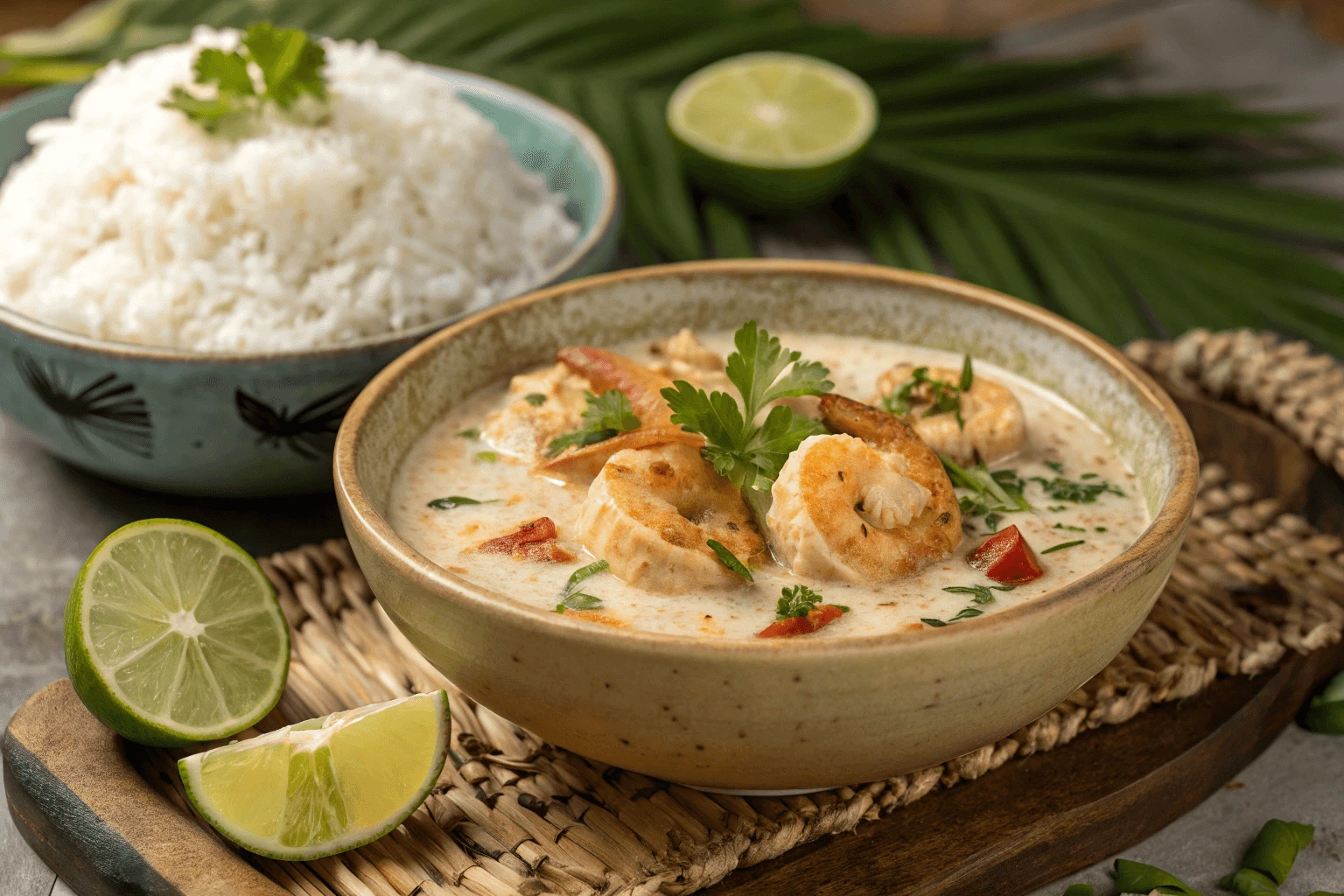There’s something magical about the combination of succulent shrimp and rich, creamy coconut sauce. This creamy coconut shrimp recipe is a perfect balance of flavors—savory, slightly sweet, and packed with tropical goodness. Whether you’re looking for a quick weeknight dinner or an impressive dish for guests, this recipe won’t disappoint.
In this article, we’ll walk you through everything from selecting the freshest shrimp to cooking methods and the best pairings. Along the way, you’ll discover why some chefs soak shrimp in milk before frying, how to make coconut milk extra creamy, and even how Chinese restaurants achieve that irresistibly tender shrimp texture.
CONTENTS
Table of Contents
Introduction to Creamy Coconut Shrimp
The Allure of Coconut Shrimp Dishes
Shrimp is a favorite in many seafood recipes, but when paired with coconut milk, it transforms into something extraordinary. The natural sweetness of coconut blends beautifully with the briny, tender shrimp, creating a dish that’s both comforting and indulgent. Across different cultures, coconut-based seafood dishes have been a staple for centuries—from Thai curries to Caribbean-style coconut shrimp.
What makes this creamy coconut shrimp recipe stand out is its silky texture and deep layers of flavor. The coconut sauce thickens perfectly, coating each bite of shrimp in a luscious, velvety glaze. With just the right mix of seasonings, it delivers an irresistible taste that’ll have you coming back for more.
Why This Creamy Version Stands Out
Many coconut shrimp recipes rely on frying, but this version lets the sauce shine. Instead of a crispy coating, the shrimp are cooked directly in the rich coconut sauce, absorbing all the flavors. This method not only makes the dish healthier but also more flavorful.
Plus, it’s incredibly easy to prepare—just a handful of ingredients and one pan! Whether you’re a kitchen pro or a beginner, you’ll love how quickly this meal comes together.
Ingredients Needed for the Perfect Creamy Coconut Shrimp
Fresh Shrimp Selection: Tips and Tricks

The foundation of a great creamy coconut shrimp recipe starts with fresh, high-quality shrimp. If possible, buy wild-caught shrimp for the best flavor. If using frozen shrimp, thaw them in the fridge overnight or under cold running water for a few minutes.
Pay attention to shrimp size—medium to large shrimp work best for this dish, as they stay juicy and don’t overcook too quickly. Also, choosing deveined shrimp can save you prep time, but if yours aren’t cleaned yet, don’t worry—we’ll cover how to do that in the next section.
Some chefs recommend soaking shrimp in milk before frying to remove any fishy smell and soften the texture. While this isn’t necessary for this dish, it can help if your shrimp have a stronger odor.
Coconut Milk: Choosing the Right Consistency
Wondering how to make coconut milk creamy? The trick lies in picking full-fat coconut milk instead of light versions. Canned coconut milk works best, as it provides a rich texture that thickens beautifully when cooked. Shake the can well before opening to mix the cream and liquid evenly.
For an extra velvety sauce, a small amount of coconut cream can be added. If your coconut milk appears too thin, simmering it for a few minutes helps concentrate the flavors and achieve the right consistency.
Essential Spices and Herbs for Flavor Enhancement
A well-balanced coconut shrimp dish needs the right mix of spices and aromatics. Key ingredients include:
- Garlic and onion – for depth and fragrance
- Ginger – adds warmth and a subtle kick
- Lime juice – brightens the dish and balances the richness
- Red pepper flakes – optional, for those who love a little heat
Step-by-Step Preparation Guide
Cleaning and Deveining Shrimp Properly

Cleaning shrimp might seem tedious, but it’s an important step for the best results. If your shrimp aren’t deveined, simply use a small knife to make a shallow cut along the back and remove the dark vein. Rinse under cold water to remove any residue.
Some chefs also soak shrimp in baking soda mixed with water for 15 minutes to improve texture. This method helps shrimp stay firm and juicy while preventing them from turning rubbery when cooked.
Marinating Shrimp for Optimal Taste
Marinating enhances the flavors, giving the shrimp time to absorb the seasonings. A simple mix of:
- Coconut milk
- Garlic
- Lime juice
- Salt and pepper
Letting the shrimp sit in this mixture for 15–20 minutes makes a noticeable difference in taste. However, avoid marinating too long, as acidic ingredients can start breaking down the shrimp’s delicate texture.
Cooking Techniques for a Creamy Sauce
Now, let’s put it all together:
- Sauté aromatics – In a pan, heat a little oil and cook garlic, onion, and ginger until fragrant.
- Add coconut milk – Pour in the coconut milk and let it simmer gently. If needed, add a bit of cornstarch mixed with water to thicken the sauce.
- Cook the shrimp – Add the marinated shrimp and cook for about 3–5 minutes per side, just until they turn pink and opaque.
- Finish with lime juice – A squeeze of lime right before serving adds the perfect zing.
Cooking Methods: Stovetop vs. Air Fryer
Traditional Stovetop Preparation
Cooking this creamy coconut shrimp recipe on the stovetop is the classic method. It allows for better control over heat and ensures the shrimp cook evenly. Here’s how:
- Heat oil in a pan – Use a non-stick or stainless steel pan for even cooking.
- Sauté aromatics – Cook garlic, ginger, and onions until fragrant.
- Simmer the coconut sauce – Pour in full-fat coconut milk and let it thicken slightly.
- Cook the shrimp – Add the marinated shrimp and cook for 3–5 minutes per side until pink and opaque.
- Finish with lime juice – This brings out all the flavors.
This method works best if you want a silky, restaurant-quality coconut sauce that coats the shrimp perfectly.
Air Fryer Alternative for a Healthier Twist
For a slightly different take, an air fryer can be used to cook the shrimp separately before adding them to the coconut sauce. This method keeps the shrimp slightly crisp on the outside while still soaking up the flavors.
- Preheat the air fryer – Set it to 375°F (190°C).
- Arrange shrimp in a single layer – Avoid overcrowding.
- Cook for 6–8 minutes, shaking halfway through.
- Prepare the sauce separately – Follow the stovetop method for the coconut sauce.
- Combine everything – Toss the air-fried shrimp in the warm sauce before serving.
Both methods work great, but if you want a richer sauce, the stovetop is the way to go. If you’re looking for a slightly lighter version, the air fryer method is a great choice!

Part 5: Serving Suggestions and Pairings
What to Serve with Creamy Coconut Shrimp?
This creamy coconut shrimp recipe pairs beautifully with a variety of side dishes. Some top choices include:
- Steamed Jasmine Rice – The neutral flavor soaks up the coconut sauce perfectly.
- Coconut Rice – If you want extra coconut flavor, cooking rice with coconut milk makes it rich and fragrant.
- Garlic Butter Noodles – A slightly indulgent option for a fuller meal.
- Grilled Vegetables – Lightly charred zucchini, bell peppers, or asparagus add freshness to the dish.
A side of crusty bread is also a great idea for scooping up every bit of that creamy coconut sauce!
Beverage Pairings to Complete Your Meal
To balance the richness of the dish, consider these drink pairings:
- White wine – A crisp Sauvignon Blanc or Chardonnay complements the creaminess.
- Coconut Water – Keeps things tropical and refreshing.
- Mango Smoothie – A fun, fruity pairing that enhances the tropical vibe.
Variations to Try
Spicy Coconut Shrimp: Adding a Kick
If you love a little heat in your meals, this variation is for you. A simple way to spice up this creamy coconut shrimp recipe is by adding red pepper flakes, chopped chili peppers, or a dash of sriracha.
Here’s how to do it:
- Sauté aromatics – Cook garlic, onion, and ginger as usual.
- Add spice early – Stir in red pepper flakes or fresh chilies while cooking the aromatics. This allows the heat to blend into the sauce.
- Adjust heat level – Taste as you go. If you want more spice, add a little extra chili sauce before serving.
- Finish with fresh herbs – A handful of cilantro or Thai basil adds a fresh contrast to the heat.
Pairing this dish with coconut rice or naan bread helps balance the spice while soaking up the flavorful sauce.
Coconut Shrimp Curry: A Flavorful Twist
Looking for a deeper, more complex flavor? Try a coconut shrimp curry variation! This twist uses curry powder or Thai red curry paste to bring out bold flavors.
- Add 1–2 teaspoons of curry powder to the coconut milk sauce.
- Stir in diced tomatoes or bell peppers for a heartier dish.
- Use fresh lemongrass or kaffir lime leaves for an extra layer of citrusy flavor.
This version pairs wonderfully with basmati rice or roti for a full meal experience.
Common Mistakes to Avoid
Overcooking Shrimp: How to Prevent It
Shrimp cook fast—and overcooked shrimp can turn rubbery in seconds. To avoid this mistake:
- Watch the color – Shrimp turn pink and opaque when done.
- Limit cook time – It only takes 3–5 minutes per side in a hot pan.
- Remove from heat early – Shrimp continue cooking slightly even after being taken off the stove.
If you’ve ever wondered, How do Chinese restaurants make shrimp so tender?, the answer lies in a special technique called velveting. This method involves briefly marinating shrimp in a mix of baking soda and water to break down proteins and create a more tender bite.
Achieving the Right Sauce Consistency
A thin coconut sauce can make the dish feel watery instead of rich and creamy. If you’re wondering, How to make my coconut milk creamy?, follow these tips:
- Use full-fat coconut milk instead of light versions.
- Let the sauce simmer for a few extra minutes to thicken.
- Add cornstarch slurry (a mix of cornstarch and water) for extra body.
Nutritional Information and Health Benefits
Caloric Content and Macronutrient Breakdown
This creamy coconut shrimp recipe is not only flavorful but also packed with nutrients. Shrimp is a lean protein source, making it a great choice for those looking for a balanced meal. A typical serving contains:
- Calories – Around 350–450 calories per serving, depending on portion size and added ingredients.
- Protein – Approximately 20–25 grams per serving, helping to keep you full.
- Healthy Fats – Coconut milk provides medium-chain triglycerides (MCTs), which are believed to support metabolism.
If you’re aiming for a lower-calorie version, you can reduce the coconut milk slightly or swap part of it for vegetable broth while still keeping the sauce creamy.
Health Benefits of Coconut and Shrimp
Both coconut milk and shrimp offer valuable health benefits:
- Shrimp is rich in omega-3 fatty acids, which support brain and heart health.
- Coconut milk contains antioxidants and healthy fats, which may aid digestion.
- Garlic and ginger, common in this recipe, have natural anti-inflammatory properties.
With these benefits, this dish is a delicious way to enjoy a nutrient-rich meal!
Frequently Asked Questions (FAQs)
Why do you soak shrimp in milk before frying?
Soaking shrimp in milk can help remove any strong fishy odors and slightly tenderize the meat. The natural enzymes in milk help break down proteins, making the shrimp taste fresher and slightly more delicate.
What to serve with creamy coconut shrimp?
There are plenty of great side options! Steamed jasmine rice is the most popular choice, but coconut rice, garlic butter noodles, or grilled vegetables also pair well with this creamy coconut shrimp recipe. A slice of crusty bread can help soak up the flavorful sauce.
How to make my coconut milk creamy?
If your coconut milk is too thin, you can:
- Use full-fat coconut milk instead of light versions.
- Shake the can well before opening to evenly mix the cream.
- Let the sauce simmer a little longer to naturally thicken.
- Stir in a small amount of coconut cream for an extra silky texture.
Why do you soak shrimp in baking soda?
Soaking shrimp in baking soda improves texture. This technique is common in Chinese restaurants, where it’s used to make shrimp softer and more springy. A quick soak (about 15 minutes) in a mixture of baking soda and water helps shrimp stay tender and juicy during cooking.
How do Chinese restaurants make shrimp so tender?
Besides the baking soda method, restaurants often use a process called velveting. This involves coating the shrimp in a light mixture of cornstarch, egg white, and oil before cooking. It helps lock in moisture and gives shrimp a signature soft bite.
Print
How to Make the Best Creamy Coconut Shrimp Recipe at Home
- Total Time: 25 minutes
Description
This creamy coconut shrimp recipe is a rich, flavorful dish that combines tender shrimp with a velvety coconut milk sauce. With hints of garlic, ginger, and lime, this tropical-inspired seafood meal is perfect for a quick weeknight dinner or a special occasion. Serve it over rice or noodles for a complete and satisfying meal.
Ingredients
- 1 lb (450g) shrimp, peeled and deveined
- 1 can (13.5 oz) full-fat coconut milk
- 2 tbsp oil (coconut or olive oil)
- 3 cloves garlic, minced
- 1 small onion, finely chopped
- 1-inch piece ginger, grated
- 1 tbsp lime juice
- 1 tsp red pepper flakes (optional for heat)
- 1 tsp curry powder (optional for extra flavor)
- 1 tbsp cornstarch (mixed with 2 tbsp water)
- Salt and black pepper, to taste
- Fresh cilantro for garnish
Instructions
- Prepare the Shrimp – If needed, clean and devein the shrimp. For extra tenderness, soak shrimp in baking soda and water for 15 minutes, then rinse well.
- Sauté Aromatics – Heat oil in a pan over medium heat. Add garlic, onion, and ginger. Sauté until fragrant, about 2 minutes.
- Add Coconut Milk – Pour in the coconut milk and stir well. Let it simmer for 5 minutes. If the sauce is too thin, mix cornstarch with water and stir it in to thicken.
- Cook the Shrimp – Add the shrimp to the sauce. Cook for 3–5 minutes, flipping once, until pink and opaque.
- Finish with Lime – Stir in lime juice and season with salt and pepper. Let everything simmer for 1–2 minutes.
- Garnish and Serve – Remove from heat and sprinkle with fresh cilantro. Serve hot over rice or noodles.
Notes
- How to make my coconut milk creamy? Use full-fat coconut milk, shake the can well before opening, and let the sauce simmer to reduce.
- Why do you soak shrimp in milk before frying? It helps remove any strong seafood smell and makes the shrimp slightly tender.
- What to serve with creamy coconut shrimp? Jasmine rice, coconut rice, or garlic butter noodles pair perfectly.
- If you love spice, add chopped chili peppers or extra red pepper flakes for heat.
- For a Thai-style twist, add Thai red curry paste and a splash of fish sauce.
- Prep Time: 10 minutes
- Cook Time: 15 minutes
- Cuisine: Asian

